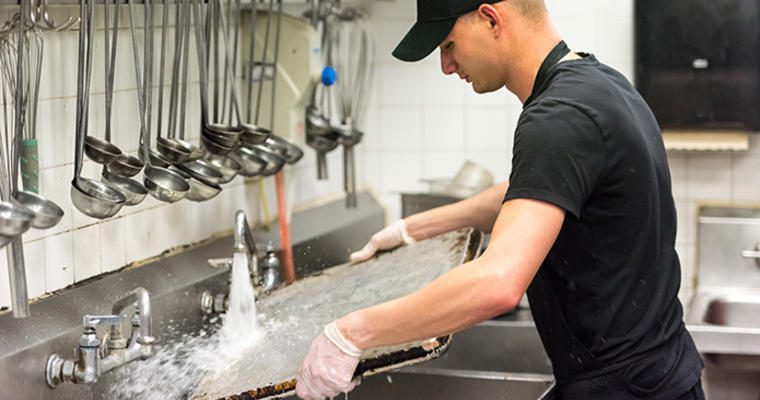Besides the obvious reasons for why prep areas, lunchrooms and dining halls need to be clean, there’s a customer-service angle to cleaning and sanitizing, too. Students and visitors, which can include parents, view a school’s dining space similar to how they would a restaurant. If it isn’t up to expectations, you may lose school foodservice participation.
People expect a clean, safe experience at a restaurant. School dining is no different. Training your staff, especially when onboarding at the beginning of the school year, is crucial. But with so much to learn and so much at risk, where should an operator start? Here are nine key points to communicate to your staff (both new and seasoned) on keeping your school’s dining areas their cleanest.
Understand the terms. Cleaning means removing food or other soil types from surfaces. Sanitizing means killing 99.99 percent of the number of specific test (that is, particular to the agent being used) related to disease-causing microorganisms on inanimate surfaces. Disinfecting means killing 100 percent of specific test related to disease-causing microorganisms on an inanimate hard surface.
Understand what should be done—and where. Sanitize where food is being served and confine disinfecting—a process using stronger agents or a stronger concentration of agents—to surfaces that don’t come in contact with food. For instance, a dining room floor can be disinfected, but not a dining room tabletop.
Follow the correct procedure. “Always clean a surface before you sanitize,” advises John Holyszko, Regional Vice President for Sales for US Chemical. That means removing visible dirt and food from a surface and then applying the sanitizing solution.
Use the right stuff. For cleaning, Holyszko recommends Array® Ready To Use Citrus Spray & Wipe as an all-purpose cleaner. For sanitizing, a quaternary ammonium compound, also known as “quat,” works well as a sanitizer and disinfectant, he says.
Follow directions. Train staff to read and follow container directions concerning how to dilute and use agents for cleaning, sanitizing and disinfecting. One important fact: In order to do their job, sanitizers must remain on a surface for anywhere from one to 10 minutes before being wiped away.
Use the right tools. A cotton rag will actually sap the sanitizing power from a solution. Instead, use disposable wipers instead of rags or cloths. Along the same line, companies that sell quat cleaners also sell quat-safe wipers.
Keep ’em separated. For safety’s sake, never use buckets, containers, wipes, and implements used for cleaning, sanitizing and disinfecting for anything else.
Stick to a schedule. Clean and sanitize tables after every meal period; give chairs the same treatment the end of each day. Run trays through a dish machine or clean them in a three-sink setup after every meal.
Consider the non-obvious. Anything students and staff touch can pick up disease-causing pathogens and thus are fair game for cleaning and sanitizing. It also includes staff kitchen apparel such as aprons and smocks: a run through the laundry with detergent at a high temperature will clean and sanitize those items.




























